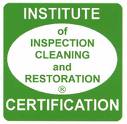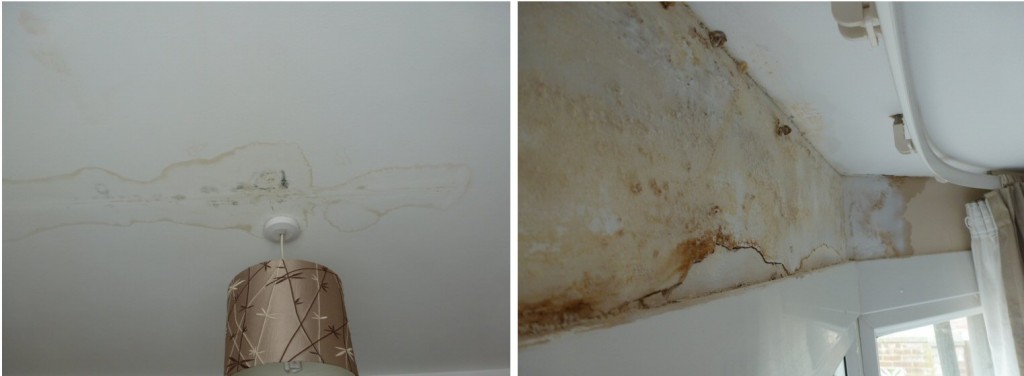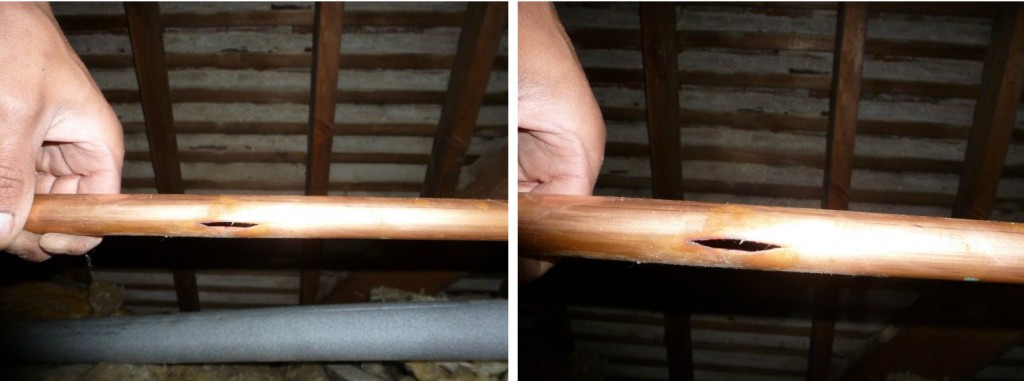Freezing pipes, Burst pipes and Water damage
April 25th, 2012
All posts, Damp / Rising Damp / Damp Proofing /, Flood Restoration & Drying, Mould Remediation, Wet Rot / Dry Rot
Freezing pipes, burst pipes and Water Damage
A burst water pipe in your home can be devastating, when a pipe breaks it can often result in complete or partial flooding of the property damaging carpets, furnishings, plaster, decorations and personal belongings. It is important to protect your water services both waste drainage and service water to defend against the risk of pipes freezing and bursting during the cold winter months. A recent damp survey on a property in York highlighted how our survey saved a client from the serious devastating effects of water damage.
We were instructed by a property management client of ours to undertake a damp survey on a property in York after recent inspections and repairs failed to resolve a reoccurring damp problem.
The property is a detached bungalow in Acomb, York, which had been split into two separate flats, for rent. During a periodic inspection the management agency noticed as slight stain started to appear on the bedroom ceiling raising suspicions of damp. A local building contractor was instructed to visit the property and investigate the cause.
The builders diagnosed the cause of damp as water ingress from the roof covering and proceeded to repair some damaged and defective roof tiles. The roof was overhauled and tiles were replaced, yet the stain on the ceiling continued to grow, plaster above a bay window also started to spoil?. The builder returned and carried out additional repairs to the roof involving re-pointing the ridge tiles, with the suspicion water was ingressing under the tiles. Weeks followed after the repairs yet still the stain on the ceiling grew, plaster above the rear bay continued to spoil, mushrooms began growing from the plaster and mould started to occur on the walls.
Confused and unable to find a resolution through the builder, the client turned to a specialist (ourselves) and instructed a survey on the property to diagnose the cause of damp.
A series of readings were taken across the ceiling using an electronic moisture meter which revealed high readings within the visibly stained area, indicating the presence of moisture. The plaster above the rear bedroom bay window where mushroom type fungus were growing again revealed high readings indicting dampness.
The” mushrooms” as described by the tenant were in fact plaster fungus “Peziza spp” which feed on surface detritus or organic material on damp brickwork and plaster. Peziza fungus are a pale brown or flesh coloured rubbery type leaf often referred to as a mushroom, which produce large mushroom like fruiting bodies easily mistaken for wood rotting fungi. They only grow on damp organic substrates and like most fungi will turn brittle when dry. Simply the presence of these healthy fruiting bodies suggested the wall and plaster was damp and has been for a prolonged period.
A through external inspection of the property revealed no serious defects with the roof covering or valleys to suggest water ingress. Damp occurring to the head of the bay window was also mysterious as the bay was sheltered by an extended soffit which protected the window and walls from the elements.
Despite this damp problem being ongoing for almost four months and numerous repairs to the roof, no-one prior to our visit had yet inspected in the roof void above the ceiling where the damage was occurring.
After squeezing my way through a tiny access hatch provided on the staircase, an inspection within the roof revealed no evidence past or previous of water entering the roof through the roof covering, there was no staining to the roof spars or ridge and the moisture content of the timbers forming the pitched roof structure was acceptable. The ceiling insulation however, was saturated and when removed revealed pockets of water standing upon the original latt and plaster lime ceiling.
The ceiling joists were also saturated and showing signs of prolonged dampness and early stage wet rot decay. There was also evidence of damp migrating from the ceiling spars onto the roof spars above the wall plate towards the bedroom rear wall directly above the damaged plaster of the bay window.
So where was the damp coming from?
Pipe work from the boiler within the attic room ran across the ceiling which was lagged in insulation. When the insulation was removed and the pipes inspected a large blister and split was observed within the pipe, RESULT!
The pipe was a discharge service from the boiler, water within the discharge pipe had frozen over winter and expanded resulting in the copper pipe fracturing and failing. Overtime when the boiler was in operation and water was expelled from the heating system it escaped from the pipe progressively saturating the ceiling, ceiling spars and tracking down the lower roof spars above the bay and soffit spoiling the plaster above the bay window. Had the ceiling of been lightweight plaster board, no doubt this would have collapsed on the unsuspecting tenants laid in bed below.
Mould had started to grow within the affected room occurring due to an increase in humidity caused by water evaporating from the saturated surfaces, this is known as ‘Secondary damage’.
As the pipe was lagged (poorly) and nobody considered inspecting the roof void this had gone unnoticed, until now. The home owner had spent a considerable amount of money, wasted on unnecessary roof repairs in addition to prolonging the problem and increasing the extent of damage.
It was only in the circumstance that this problem had not been resolved and the walls and plaster deteriorated further they turned to a specialist in damp diagnosis and repair. The survey cost our client only £60.00 + VAT a fraction of the price paid for the numerous failed roof repairs. Our survey revealed the problem instantly for which an immediate repair to the damaged pipe was instructed and undertaken.
Luckily for the client we also specialise in flood remediation and drying as an IICRC (Institute of Inspection Cleaning and Restoration Certification) certified company, therefore we were able to produce a specification for their insurance company for repairing the damaged plaster, drying the ceiling, walls and roof and provide a drying certificate. We were also able to guarantee all the work undertaken. In this circumstance through our specialist drying we were able to save the ceiling and majority of plaster with exception to the head of the bay window, which saved our clients even more money.
A prompt response, professional inspection and correct diagnosis by a specialist in damp provided immediate repair and saved our client allot of money by being able to salvage the ceiling with an effective drying system, it is just a shame they hadn’t considered contacting a specialist company from the start otherwise we could have saved them even more without the unnecessary roof repairs.
I would like to say this event is uncommon however, we see these problems daily. Within only the past six weeks I have been involved in five separate surveys which were the result of burst or failed water services, which the cause had been miss diagnosed by others.
 At Dryfix our surveyors are fully qualified through examination by our leading industry body the Property Care Association (PCA) and have a wealth of experience within the remedial industry specialising in damp, decay, infestation, water damage and structural repair. We are also a IICRC (Institute of Inspection Cleaning and Restoration Certification) certified company specialising is flood/water damage and drying of buildings. Our surveyors carry all the latest diagnosis and inspection equipment including fibre optical cameras, moisture analysis equipment and thermal imaging cameras.
At Dryfix our surveyors are fully qualified through examination by our leading industry body the Property Care Association (PCA) and have a wealth of experience within the remedial industry specialising in damp, decay, infestation, water damage and structural repair. We are also a IICRC (Institute of Inspection Cleaning and Restoration Certification) certified company specialising is flood/water damage and drying of buildings. Our surveyors carry all the latest diagnosis and inspection equipment including fibre optical cameras, moisture analysis equipment and thermal imaging cameras.
If you discover a damp problem, save yourself time and money and get correct diagnosis first time.
If you suspect a problem please don’t hesitate to contact “Yorkshires Leading Damp and Timber Specialists” Dryfix Preservation Ltd.
for more information visit our website www.dryfix.net
Russell Rafton
C.S.R.T / I.S.S.E
Dryfix Preservation Ltd – Surveyor
For advice on how to prevent freezing pipes or what to do if you discover a pipe has burst read our Beat the freeze Blog; www.dryfix.net/blog/






